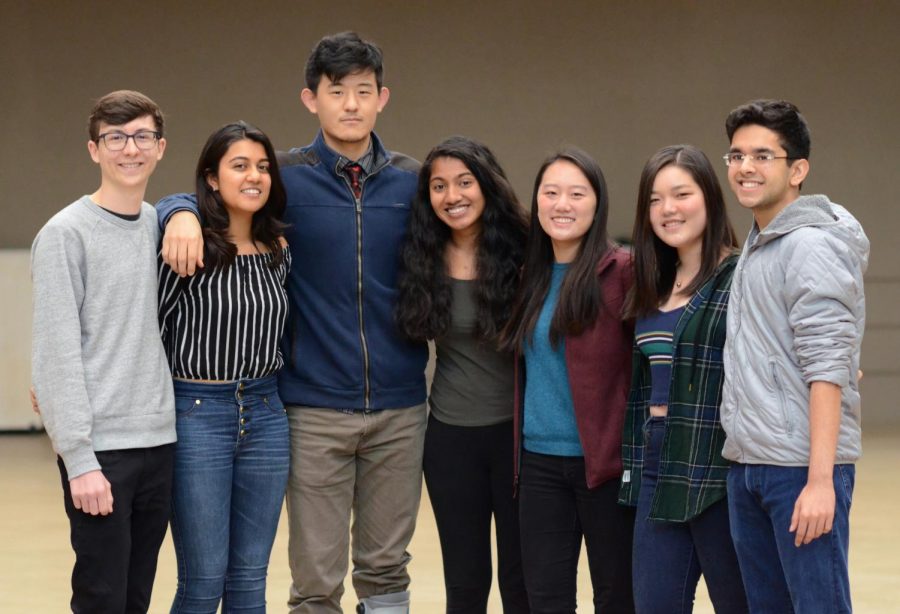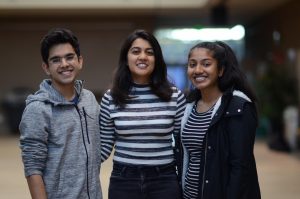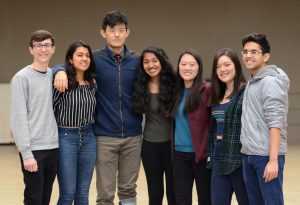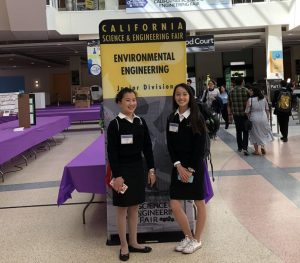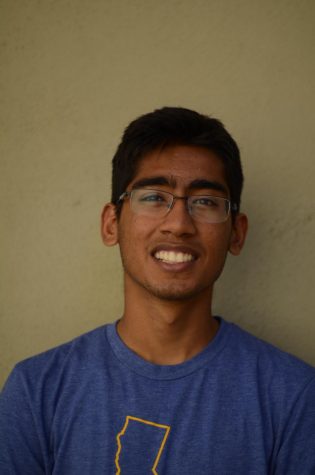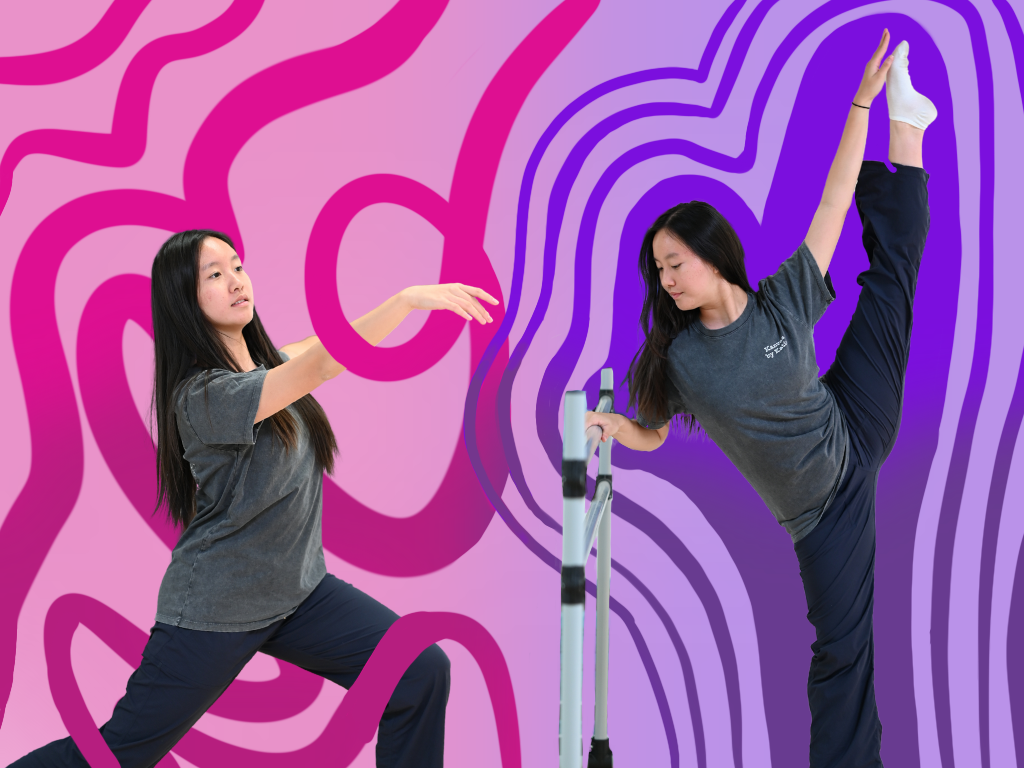The apex of high school research: upper school seniors win accolades as Regeneron STS scholars and finalists
Harker’s 2019 Regeneron Science Talent Search scholars pose for a picture. From left to right: Cameron Jones, Natasha Maniar, Richard Wang, Ruhi Sayana, Katherine Tian, Cindy Wang and Ayush Alag, all seniors. Natasha, Ruhi, and Ayush were finalists as well.
February 28, 2019
Using deep learning to improve therapy for arrhythmia. Finding a target treatment for a high-risk form of childhood cancer. Analyzing genomic data to help diagnose food allergies. These projects landed seniors Ruhi Sayana, Natasha Maniar and Ayush Alag, respectively, spots in the list of 40 Regeneron Science Talent Search (STS) finalists on Jan. 23.
The original list of the 300 “scholars” was announced on Jan. 9, and included seniors Cameron Jones, Katherine Tian, Cindy Wang and Richard Wang in addition to the three finalists. These scholars were chosen out of 1,964 entrants, according to the Regeneron website.
Each scholar received a $2,000 prize, with an additional $2,000 given to Harker for each of the seven semifinalists. Harker had the fourth-most scholars from any school and tied for most finalists, with seven and three seniors in the respective categories. This echoes results from previous years, as Harker had two finalists in 2018 and three in 2017.
The Regeneron STS, which originally began 78 years ago, is a science competition which elicits submissions from high school seniors who are U.S. residents or U.S. regarding their individual research from any year of high school.
“We love to see alumni who came out of this program who had the similar goal when they were in high school to learn the ins and outs of scientific research, and somehow those tools have helped them in their career make a positive difference in the world,” Allie Stifel, the director of STS, said.
Though the research project is a major component of the submission, Regeneron also considers aspects of the applicant other than their research.
“We’re also looking to see does this student have grades that back up this great research, does this student have strong letters of recommendation from their teachers and from their project mentors,” Stifel said. “We’re just looking for future leaders who also care about science and show a level of dedication.”
Given these considerations, the Regeneron application also requires a number of essays on the application along with the research.
“I would say if you’re sure you want to do it, try to come to school with a draft. I know that seems really early given the deadline isn’t until November, but you really need a lot of time to write the essays especially because you’re a senior and you’re also doing college apps,” Mr. Chris Spenner, upper school science research teacher and Research Club advisor, said.
The STS does not include quotas for research categories and geographic location, making it an entirely merit-based competition. Spenner noted that experiments that combine aspects of both computation and lab work tend to perform well in the STS.
“We have this continuing trend of students doing computational work which is to be expected partly because our students are well trained in computer science and also [because] computational work is also just more accessible to high school students,” he said. “[But] I think there are more and more projects that are combining both wet lab results and computational analysis, [and] those tend to be more successful.”
The three finalists all employed computational analysis in their projects. Ayush’s project focused on creating a computer model to analyze genetic biomarkers that could indicate whether a person suffered from certain allergies.
“I personally have food allergies and I had to endure a lot of the inaccurate tests to try to distinguish whether I was food sensitized or allergic,” Ayush said. “From there I was kind of motivated to see what’s going on in this field, why isn’t there a better diagnostic method [and] that spurred my research.”
Meanwhile, Natasha built a deep learning model to detect arrhythmia based on electrical patterns in the heart. Her research was inspired by her family’s history with cardiovascular disease, and the accolade of being named a finalist gave her affirmation that she is on the right path.
“I think to be at that level tells me that all the research I’ve been doing will someday have an impact and they can see the potential in my work to have an impact on the world. That’s very gratifying,” Natasha said.
Ruhi’s research combined wet lab experiments and computational tools to find a target treatment for a form of childhood cancer known as hypodiploid B-ALL by analyzing which proteins were overexpressed in the cancer and using a drug to target these proteins.
“I’ve always wanted to be a pediatric oncologist from a very young age just because I love working with kids and I know that pediatric oncology is not very [well] funded,” Ruhi said. “The summer after freshman year I finally got an opportunity to join a pediatric oncology lab and [that] I think was what drew me to this topic.”
Finalists earn the chance to compete nationally in Washington D.C. from Mar. 7 to 13 and showcase their work to professional scientists, as well as win up to $250,000 for a first place finish. They are guaranteed at the minimum a $20,000 reward.
“The whole week seems really cool,” Ayush said. “Meeting the top 40 … and learning from how they’ve conducted their research, because as a researcher you can always learn from other people think and go about investigating problems — that’s something I’m looking forward to.”
Regeneron applications, available to all current juniors, will open June 1 and close in November.
An abridged version of this piece was originally published in the pages of The Winged Post on February 20, 2019.


















![“[Building nerf blasters] became this outlet of creativity for me that hasn't been matched by anything else. The process [of] making a build complete to your desire is such a painstakingly difficult process, but I've had to learn from [the skills needed from] soldering to proper painting. There's so many different options for everything, if you think about it, it exists. The best part is [that] if it doesn't exist, you can build it yourself," Ishaan Parate said.](https://harkeraquila.com/wp-content/uploads/2022/08/DSC_8149-900x604.jpg)




![“When I came into high school, I was ready to be a follower. But DECA was a game changer for me. It helped me overcome my fear of public speaking, and it's played such a major role in who I've become today. To be able to successfully lead a chapter of 150 students, an officer team and be one of the upperclassmen I once really admired is something I'm [really] proud of,” Anvitha Tummala ('21) said.](https://harkeraquila.com/wp-content/uploads/2021/07/Screen-Shot-2021-07-25-at-9.50.05-AM-900x594.png)







![“I think getting up in the morning and having a sense of purpose [is exciting]. I think without a certain amount of drive, life is kind of obsolete and mundane, and I think having that every single day is what makes each day unique and kind of makes life exciting,” Neymika Jain (12) said.](https://harkeraquila.com/wp-content/uploads/2017/06/Screen-Shot-2017-06-03-at-4.54.16-PM.png)








![“My slogan is ‘slow feet, don’t eat, and I’m hungry.’ You need to run fast to get where you are–you aren't going to get those championships if you aren't fast,” Angel Cervantes (12) said. “I want to do well in school on my tests and in track and win championships for my team. I live by that, [and] I can do that anywhere: in the classroom or on the field.”](https://harkeraquila.com/wp-content/uploads/2018/06/DSC5146-900x601.jpg)
![“[Volleyball has] taught me how to fall correctly, and another thing it taught is that you don’t have to be the best at something to be good at it. If you just hit the ball in a smart way, then it still scores points and you’re good at it. You could be a background player and still make a much bigger impact on the team than you would think,” Anya Gert (’20) said.](https://harkeraquila.com/wp-content/uploads/2020/06/AnnaGert_JinTuan_HoHPhotoEdited-600x900.jpeg)

![“I'm not nearly there yet, but [my confidence has] definitely been getting better since I was pretty shy and timid coming into Harker my freshman year. I know that there's a lot of people that are really confident in what they do, and I really admire them. Everyone's so driven and that has really pushed me to kind of try to find my own place in high school and be more confident,” Alyssa Huang (’20) said.](https://harkeraquila.com/wp-content/uploads/2020/06/AlyssaHuang_EmilyChen_HoHPhoto-900x749.jpeg)



